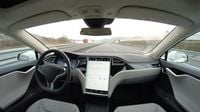Electric vehicle (EV) drivers traveling Pennsylvania’s highways and Texans eyeing the future of mobility both received major jolts of news this week. On the Pennsylvania Turnpike, a critical artery that stretches 360 miles from Pittsburgh through Harrisburg to Philadelphia, two new Applegreen DC fast charging stations have come online at the North Somerset and South Somerset service plazas. Meanwhile, in Texas, Tesla’s much-anticipated Robotaxi service has received the green light to operate driverless vehicles across the state, marking a significant step in the evolution of autonomous transportation.
The Pennsylvania Turnpike’s latest charging stations, located at milepost 112.3 for both westbound and eastbound travelers, are more than just another amenity—they’re a sign of the rapid transformation of America’s transportation infrastructure. Each of these two sites features two DC fast chargers, providing a total of four charging ports at each plaza. Importantly, the chargers are equipped with both NACS and CCS plugs, ensuring compatibility for a wide range of EVs now on the road. And as Keith Jack, Director of Facilities Operations for the Pennsylvania Turnpike, put it, “We are pleased to offer our EV customers convenient access to the latest, fastest technology – without leaving the PA Turnpike.” According to Electrek, the sites are designed with expansion in mind, so drivers can expect even more charging capacity in the future.
This isn’t the Turnpike’s first foray into EV infrastructure. The very first charger was installed back in April 2014. Fast forward a decade, and the number of EV chargers now exceeds 60 across eight service plazas, with the network only set to grow. Thanks to a new partnership with Applegreen Electric, 80 new universal EV chargers are on the way, and by 2027, all 17 service plazas along the Pennsylvania Turnpike will be equipped with DC fast chargers. That’s a big deal for anyone worried about running out of juice on a long haul across the state.
The funding for these advances has come from a mix of state and federal sources. The new chargers at North Somerset, South Somerset, and an upcoming installation at the Hickory Run Service Plaza (scheduled to open this fall) were made possible by grants from the Pennsylvania Department of Environmental Protection’s Driving PA Forward program. Looking further ahead, nine additional service plazas scheduled to open in 2027 will see chargers funded through the Biden administration’s federal National Electric Vehicle Infrastructure (NEVI) program—a key piece of the White House’s push to modernize America’s roads and promote clean transportation.
Applegreen Electric isn’t just making moves in Pennsylvania. According to Electrek, the company is also rolling out fast chargers on the New Jersey Turnpike under an exclusive agreement, taking over from Tesla. As Eugene Moore, Applegreen Electric’s chief executive, explained, “The PA Turnpike’s fast charger rollout marks a key step in building a connected corridor with Pennsylvania as a vital part of the seamless network that now spans New Jersey, New York, Connecticut, and Delaware. With more to come soon in Ohio and Massachusetts, we’re accelerating the rollout of reliable, accessible EV infrastructure across the region.” For drivers, that means a future where range anxiety could become a thing of the past.
But it’s not just stationary infrastructure that’s making headlines. Down in Texas, the roads themselves are about to get a lot smarter—and maybe a little stranger. Tesla Robotaxi LLC has officially received a permit from the Texas Department of Licensing and Regulation to operate driverless Robotaxi vehicles statewide through August 6, 2026, according to Drive Tesla. This decision follows the state’s new autonomous vehicle law, which required Tesla to obtain a permit before launching its service.
The rollout began modestly. In June, a limited Robotaxi service launched in Austin with a small fleet of Model Y vehicles, each accompanied by onboard safety operators. But the real milestone is yet to come: Tesla CEO Elon Musk has announced that the Robotaxi service will open to the general public in September. However, as Drive Tesla Canada reports, there’s still no firm date for when fully autonomous rides—meaning those without any human safety operator onboard—will become a reality.
This development comes at a time of mixed fortunes for Tesla. While its Model Y and Model 3 remain dominant in the U.S.—accounting for 43% of all EVs sold in the country during the second quarter of 2025, according to MarketWatch—Tesla sales have been slipping abroad. In July, new Tesla registrations dropped nearly 60% in the United Kingdom and fell 55% in Germany. Still, the overall EV market is surging: the International Energy Agency projects that electric vehicles will account for more than a quarter of all vehicles sold globally in 2025, with EV sales up 35% year-on-year in just the first quarter of 2025.
Why does all this matter? Beyond the convenience and cool factor, the shift to electric and autonomous vehicles carries major environmental implications. As the U.S. Environmental Protection Agency points out, EVs produce zero tailpipe pollution and, even when accounting for the electricity used for charging, are responsible for about half as much carbon pollution per mile as gas-powered cars. MIT researchers back this up, highlighting the efficiency gains and emissions reductions that come with widespread EV adoption. For drivers, there’s also a financial incentive: EV owners can save hundreds of dollars a year on gas and maintenance compared to their combustion-engine counterparts.
There’s another angle to the EV revolution too—one that’s quietly reshaping how Americans power their homes and cars. Installing solar panels at home is being promoted as a way for EV drivers to save even more money. Charging with solar energy is not only greener but often cheaper than public charging stations or relying on the grid. Services like EnergySage are making it easier for homeowners to compare quotes from local installers, with the potential to save up to $10,000 on solar installations. This convergence of clean energy and clean transportation is, for many, the ultimate win-win.
As the infrastructure for EVs and autonomous vehicles continues to expand—on highways, at home, and everywhere in between—the landscape of American transportation is changing at a breakneck pace. Whether you’re a road-tripper crossing Pennsylvania, a commuter in Austin, or a homeowner looking to go solar, the message is clear: the future of driving is electric, connected, and increasingly autonomous. And if the latest developments are any indication, that future is arriving faster than anyone might have guessed just a few years ago.
With every new charger installed and every robotaxi hitting the road, the path toward a cleaner, smarter, and more efficient transportation system is being paved—sometimes literally—right before our eyes.




